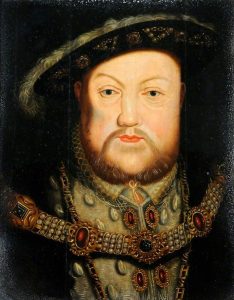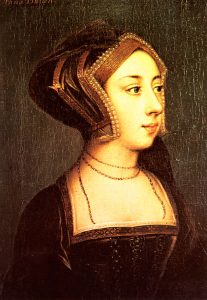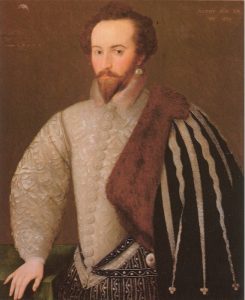Before the Tudors rose to power in England, there was a fight for the throne between two branches of the Plantagenet royal family. The battles between the House of Lancaster (sound familiar?) and the House of York eventually led to a series of civil wars called the Wars of the Roses in the 1400s. The Lancasters took as their symbol the red rose, while the House of York took the white rose as theirs. Despite the pretty emblems, the battles between England's citizens were ugly, and it took a royal marriage that united the two warring houses to bring lasting peace. Henry Tudor, who would be crowned Henry VII, married Princess Elizabeth of York. Their joint symbol was a rose with red petals surrounding the white - a Tudor rose, it represented the House of Tudor, which was the name of the new royal family. Henry VII and Queen Elizabeth's children who lived to adulthood included: Arthur (Prince of Wales), Margaret (queen consort of James IV of Scotland and grandmother of Mary, Queen of Scots), Henry (who succeeded his father as Henry VIII), and Mary (queen of France as wife to Louis XII and grandmother of Lady Jane Grey).
The Tudor Family's Troubles
King Henry VIII of England was a big, red-haired man who liked to joust and feast. He also liked the ladies. For many years, he was mostly content with his marriage to Catherine of Aragon, a Spanish princess who happened to be the widow of his brother, Arthur. Henry and Catherine had a daughter named Mary, but no other children lived to maturity. On Henry's death, Mary was next in line to inherit the throne. Henry very much wanted a strong son to carry on his dynastic name and keep the kingdom safe as daughters were perceived as being weaker than sons and less able to rule independently.
Since, after many years of marriage, Catherine hadn't given Henry the son he wanted, he decided he would get his marriage annulled so he could marry someone else. He had his eye on a young woman at his court named Anne Boleyn. If his marriage were annulled, it would be the same as if it had never taken place in the eyes of the law and the Catholic Church. As a faithful Catholic, he couldn't annul his marriage on his own. He had to ask the Pope's permission, and the Pope would not give it, as Catherine had been true to her marriage vows for many years.
At this same time in Germany and other parts of Europe, a movement took place called the Protestant Reformation. People such as Martin Luther, a former German priest, wanted to start new churches where the Pope and the established Church hierarchy had no say. Henry decided that he would start a church also, called the Church of England. The King was the head of this church. One of the first things he did was to grant himself a divorce from Catherine. This made his daughter Mary illegitimate and therefore not eligible for the throne - unless he had no other male heirs.
When Henry took charge of his new church, he got rid of the old ways. No more monasteries. Those rich buildings, lands and what they produced went to the King and the King's faithful lords. No more Catholic priests. No more masses presided over by Catholic priests. English citizens who were devoutly Catholic in their beliefs hated these new rules and often attended masses in secret, even under threat of dire punishment. The wealthier families might create hiding places for the priests in their manor houses called priests' holes.
Henry lost no time in marrying his second wife. On September 7, 1533, now-queen Anne Boleyn gave him a daughter named Elizabeth who should have filled him with pride. But, she was a daughter, and that wasn't good enough for Henry. He got rid of Anne - she stood trial for adultery, was convicted and beheaded - and the king married again. And again. And again. In all, Henry VIII had six wives. Wife number three, Jane Seymour, did give Henry a son before she died of childbed fever. But young Prince Edward was never very healthy.
When Henry VIII finally died in 1547, young King Edward was determined to keep the country Protestant as his father had decreed it. During his short rule, his father's new church - the Church of England - stopped saying its services in Latin and adopted a new English-language prayer book, The Book of Common Prayer, which made the Catholics - whose traditional services were said in Latin - even less happy.
When 15-year-old Edward died in 1553, Mary, Catherine of Aragon's daughter, became the new ruler. She was determined to turn England completely back to Catholicism - no matter the cost. She was so ruthless in putting to death Protestants who opposed her that she earned the nickname Bloody Mary. She hoped to keep the country Catholic by marrying Prince Philip of Spain, but it was not to be. Although they did wed, Philip and Mary had no children, and in 1558 Mary died. Her unmarried sister, Elizabeth, became queen. Despite her father's (and much of the court's) misgivings, she was a strong queen who led England through difficult days - but there was plenty of blood on her hands as well, including that of her cousin, Mary - Queen of Scots.
A Timeline:
1509 - Henry VII (First Tudor monarch) dies
His son, Henry VIII, becomes king
Henry VIII's wives:
1509-1533 Catherine of Aragon (Annulled/lived - child Mary, later Mary I)
1533-1536 Anne Boleyn (Annulled/beheaded - child Elizabeth, later Elizabeth I)
1536-1537 Jane Seymour (Died of childbirth complications - child Edward, later Edward VI)
1540-1540 Anne of Cleves (Annulled/lived)
1540-1541 Catherine Howard (Beheaded)
1543-1547 Catherine Parr (Survived Henry and remarried)
1547 - Henry VIII dies
Edward VI becomes king
1553 - Edward VI dies
Lady Jane Grey becomes queen
1553 - Queen Jane is overthrown after 9 days, and Mary I (Edward's half-sister) becomes queen. She marries Prince Philip of Spain in 1554. No children.
1558 - Mary I dies
Elizabeth I (her half-sister) becomes queen
1587 - Mary Stuart, Queen of Scots, is put to death on Elizabeth's order
1588 - The destruction of the Spanish Armada is a major English victory.
1603 - Elizabeth I dies without a direct heir
James I (James VI of Scotland and son of Mary, Queen of Scots) becomes king of England. He will survive two plots to dethrone him in his first year alone - but he will rule until 1625.
Elizabeth decided not to persecute the Catholics unless they tried to overthrow her rule. In 1563, a compromise was struck (The Thirty-Nine Articles) which allowed some measure of religious freedom for Catholics.
Plots and Treachery
There were those, including the King of Spain and the Pope in Rome as well as Catholic English citizens, who wanted to turn England back into a Catholic country. They supported Mary Stuart's, also known as Mary, Queen of Scots, efforts to overthrow Elizabeth and take the English throne as well. Some English Catholics remained loyal to Elizabeth while others joined the rebels. Eventually, Elizabeth imprisoned Mary the Scottish queen and had her put to death, along with others who were judged to be traitors to the Crown.
The Queen's Favorites: The Gypsy, the Dragon, and Others
Although she never married and was never proven to have any significant romantic interests, Elizabeth did have her favorites. They were men of intelligence, ambition, and daring who swore to serve the Queen - while also serving their own interests.
Robert Dudley, Earl of Leicester (pronounced "Lester"), had a lot of influence with Elizabeth. From the time she came to the throne in 1558 until his death in 1588, he was her "dear Robin." Elizabeth gave him generous gifts of lands and money. One of her most trusted ministers, William Cecil (Lord Burghley), disliked Leicester intensely for his influence on the Queen. On Lord Burghley's deathbed, he warned the queen of "the gypsy's" evil influence. Dudley got along better with Francis Walsingham, another minister who was known as the Queen's spymaster. Dudley's hopes to marry Elizabeth were never realized, and eventually, he married elsewhere. His stepson, Robert Devereux (Earl of Essex), became another young favorite of the aging queen. As his star was fading and another's rose, Essex made some treasonable overtures to King James VI of Scotland (Mary, Queen of Scots' son). He was found out, tried, and executed.
At their first meeting, Sir Walter Raleigh famously spread his fine cloak over a puddle so the queen need not get her feet wet. She was intrigued with the handsome soldier from Devon who spoke intelligently of politics. He stayed at court for many years and made an enemy of the Earl of Leicester, who was jealous of his influence with the queen. He was also enemies with the Earl of Essex. Raleigh (also spelled Ralegh) became very rich from the queen's gifts and the booty from his privateering (piracy with permission from the Crown). Raleigh was knighted in 1585 for his plans to found a colony in the New World, which he had already named Virginia after Elizabeth, "the Virgin Queen." In later years, he fell from favor at court. He then searched for the fabled El Dorado, the city of gold, but he never found it. Elizabeth's successor, King James I (son of Mary, Queen of Scots), imprisoned him for 15 years and eventually executed him.
Sir Francis Drake was another soldier/sailor from Devon. He and Captain Hawkins set out to prey upon the Spanish fleet to make up for their losses when the Spanish destroyed some of their vessels in Spanish America. He and the other "sea hawks" brought Elizabeth much gold from Spanish ships. In 1577, he set sail on the Golden Hind (also known as the Pelican) and sailed the world round, through the Pacific. When he came home to England in 1580, his ship laden with spices from the East and Spanish gold, the Spanish ambassador demanded that he and his crew be hanged as pirates. Elizabeth declared that the Spanish had treated English ships in much the same way. Furthermore, she declared that English ships had a right to sail anywhere! She made sure the Spanish got her point by knighting Francis Drake, whom the Spanish now called "El Draque" (the dragon). He was a commander when Spain tried to invade England by sea. The defeat of the Spanish Armada in 1588 began England's long period of sea dominance across the world.
The Renaissance in England
Elizabeth's long reign was by and large peaceful and prosperous at home. She encouraged not only local industries but also the arts. She was a patron of a young playwright named William Shakespeare. He performed and wrote plays as part of a group called The Lord Chamberlain's Men, who built their own Globe Theatre in 1597. Other famous writers included Christopher Marlowe, Ben Jonson, Edmund Spenser, and Sir Francis Bacon. By the end of Elizabeth's reign, England's literacy rate had grown hugely: 30 percent overall and 60 percent for Londoners. The world was truly opening for England and her citizens. Across the Atlantic, England's expansion into the New World brought a promise of freedom for those English citizens who still felt fettered by the Old World's ways of religion, society, and politics.
When she died at last in 1603, she passed her throne on to the James, the Protestant son of Mary, Queen of Scots. James ordered the creation of the Authorised King James' Version of the Bible, a new English translation for Protestant worshippers. He was somewhat tolerant of Catholicism until the Gunpowder Plot of 1605 in which Guy Fawkes and other Roman Catholic conspirators tried to blow up Parliament. James' rule would be the start of a new dynasty, the Stuart Dynasty.
If the Gunpowder Plot conspirators had had their way, the next ruler would either have been Isabella, daughter of King Philip II of Spain, or possibly Arbella (Arabella) Stuart, a cousin to both Elizabeth and James. Arbella lived in England, and, even though she had no interest in the throne, she was arrested and imprisoned in the Tower of London just in case someone might try to put her there. She died in prison of an illness brought on by her hunger strike. They laid her lead coffin on top of Mary, Queen of Scots'.
If you like your history interpreted on film, check out the video list:
Back when monarchs ruled very nearly absolutely, the scramble for the throne played out over a long game of chance, romance, intrigue, and frequently violence. Most of these films are based on books.
If you enjoy reading history as stories, peruse these novels featuring the daring and dangerous characters from Tudor times.
The Tudor Royals brought new levels of affluence and high-stakes intrigue to the English court. The rewards were dazzling, but the penalties for missteps deadly - whether you were in line for the throne or just part of his or her inner circle.










